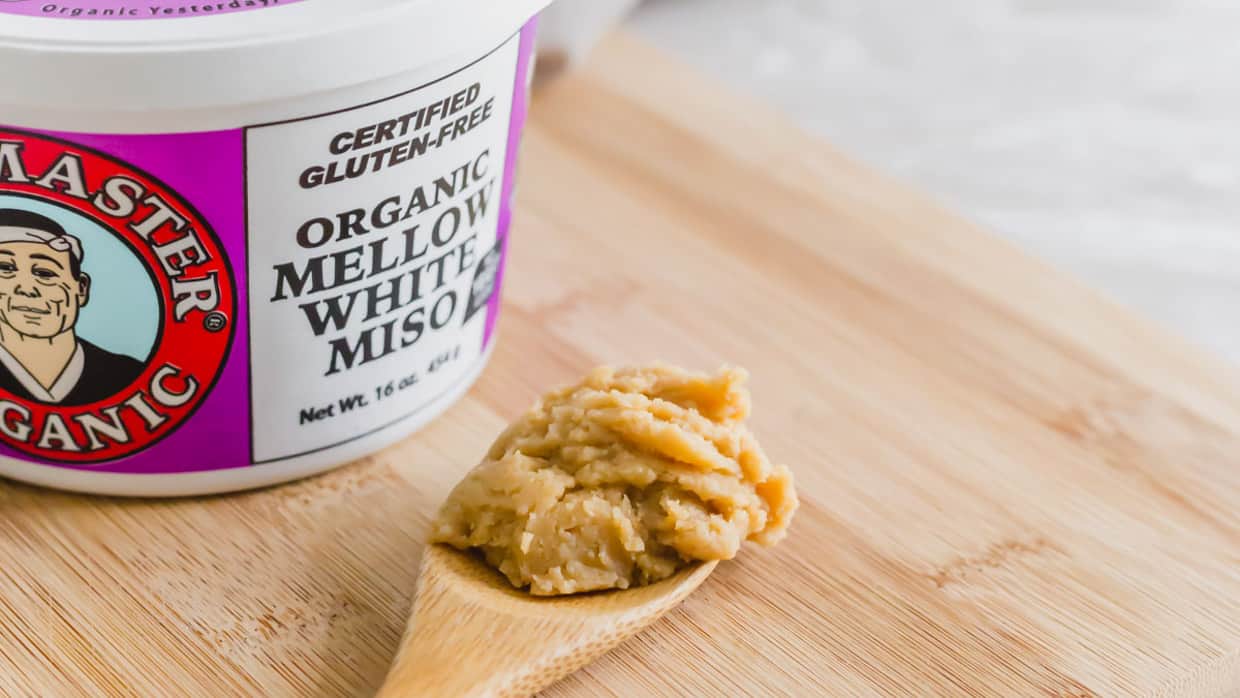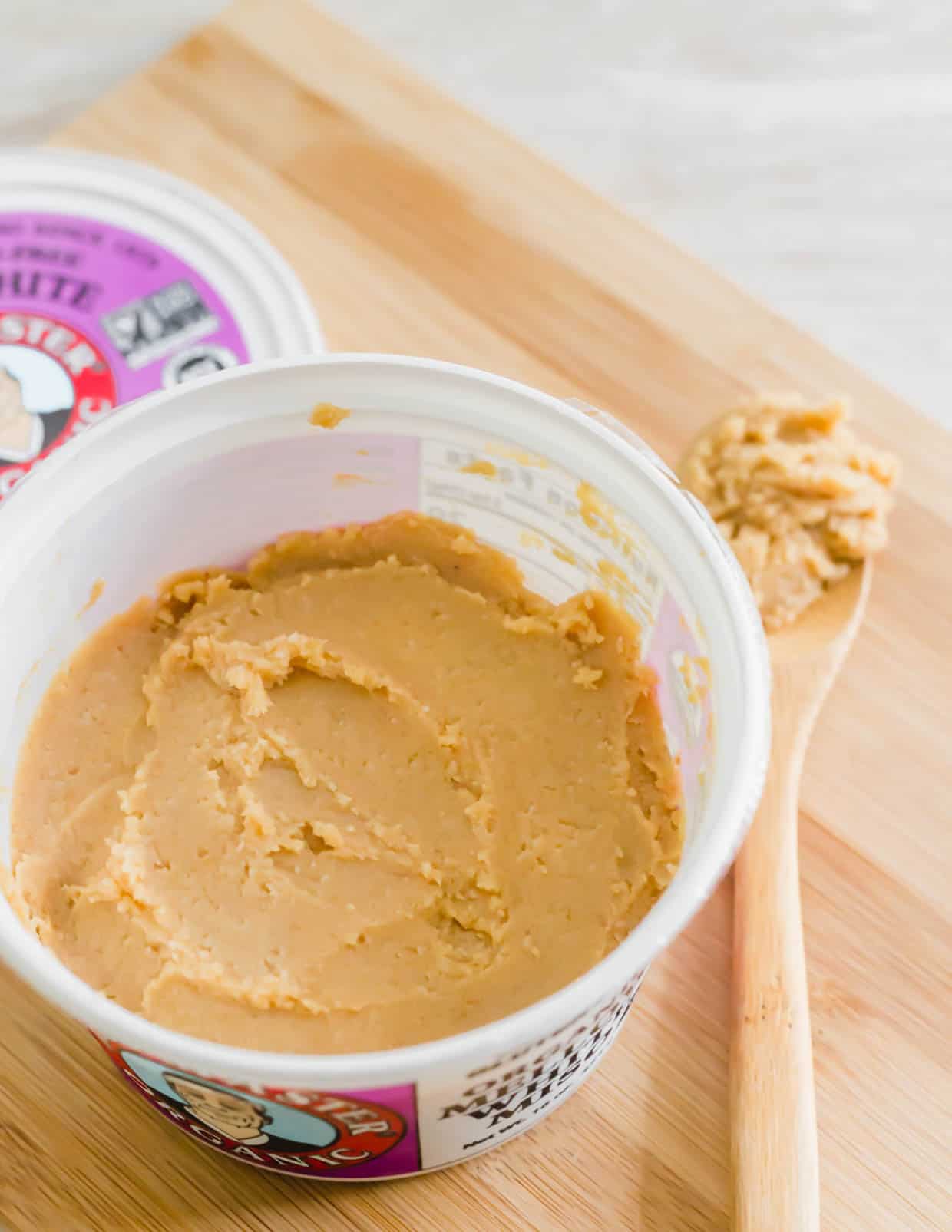From dressings to marinades, sauces to broths, miso paste brings unmatched umami flavor and depth. However, if you find yourself without miso paste in your pantry, fear not. In this article, we’ll explore the best alternatives that can help you achieve that savory, complex and distinctive taste.

What is miso paste?
Miso paste is a traditional Japanese paste made of fermented soybeans. Salt and a specific fungus, a koji starter, is added and sometimes a grain such as barley or rye.
Unlike chili paste, miso paste is not spicy but instead boasts a deep salty, earthy, subtly sweet and funky flavor.
It’s worth noting the difference between miso paste and soybean paste as they are not the same. Miso tastes a touch sweeter than soybean paste because of the added koji starter.
If you’re following a gluten-free diet make sure to read the ingredient label to ensure there are no added grains. The brand Miso Master is widely available in the U.S. and is both organic and gluten free.
There are several types of miso pastes, which include:
- white miso paste
- red miso paste
- yellow miso paste
- brown miso paste
They all taste a little bit different, the darker the miso the stronger the flavor, but a common favorite to keep on hand for general-purpose use is white miso paste. Also known as shiro miso, it’s both mild in flavor and flexible for use in a variety of recipes.
These miso substitutes discussed in this article are suitable to use for any variety of miso paste.
Where to find miso paste
Before discussing the best substitutes for miso paste, it’s worth noting where you may be able to locate miso paste for future use. As such a unique and impactful ingredient with an extended shelf-life, it’s worth the effort to seek out.
Miso paste can be located in most supermarkets in the refrigerated section, usually near the tofu or tempeh.
Using it with both those ingredients is very commonplace. Whether it’s in a tempeh marinade or air-fried tofu.
Most conventional grocery stores now carry miso paste but you can be guaranteed to locate it in a store like Whole Foods or Sprouts.

FDL’S 75 Best Bites

Our cookbook with 75 tasty recipes will be your go-to kitchen companion for easy dinners with ad-free recipes right at your fingertips. Crafted by experienced chefs and recipe developers, this collection offers a treasure trove of tried-and-true dishes that make mealtime a breeze.
Get the Recipe: FDL’S 75 Best Bites
The best miso paste substitutes
These common household ingredients can make good substitutes for miso paste in different situations. They perform best when miso paste is part of a larger list of ingredients, not center stage in the recipe. In those cases, it’s best to source the real thing and save the recipe for another time.
Soy sauce
Soy sauce is probably the most common miso substitute. Most will have this ingredient in the refrigerator already and if you’re gluten free or paleo, both tamari (usually gluten free) or coconut aminos (gluten free and soy free) also make good stand-ins for miso paste.
Soy sauce does a great job of mimicking the salty flavor of miso paste but its most obvious downfall is the difference in consistency. Soy sauce is a thin liquid while miso paste is more creamy and paste-like in texture.
If you choose to use soy sauce in place of miso paste, a good rule of thumb is to use half the amount of soy sauce for the amount of miso paste.
The dressing of this bok choy salad is a great example where soy sauce or miso paste can be used interchangeably.
Fish sauce
Fish sauce is another good substitute for miso paste in that it has the same salty, umami flavor profile. Like soy sauce, however, fish sauce is also much thinner in texture than miso paste.
Fish sauce is made from fermented fish so it’s not substitutable for vegetarians or vegans but its salty, funky flavor is a very close match to miso paste.
The one caveat with using fish sauce is the difference in strength. It cannot be swapped out in a one-to-one ratio. A little goes a long way with this ingredient.
Use about one quarter the amount of fish sauce for the specified amount of miso paste in a recipe.

Tahini
Tahini is a great miso substitute because it’s almost identical from a textural standpoint. Its creaminess is a great match for miso paste especially when used as a sauce such as to coat Asian noodles.
Tahini is also commonly used in dressings or to create dipping sauces for things like roasted vegetables or fries. Roasted romanesco with turmeric tahini sauce is a mouthwatering recipe that showcases its texture and flavor.
Miso paste can easily be swapped out for the tahini and vice versa in a one-to-one ratio in these types of recipes.
Tahini is essentially a sesame seed butter made by grinding the seeds until creamy and smooth. While the texture is spot on for a miso paste substitute, its flavor profile is a bit different.
Where miso paste is salty and umami, tahini is more nutty and a touch bitter.
Tahini is a good miso substitute if the recipe calls for a small amount of miso paste. A good rule of thumb for using tahini in place of miso is if the recipe calls for two tablespoons or less.
For any larger amounts, use a combination of tahini and either soy sauce or fish sauce to create a substitute that’s more accurate from both a texture and flavor standpoint.
Salt
Last but not least may be the easiest of all the miso paste substitute swaps — salt.
Salt is perfect if a recipe only calls for a very small amount of miso paste. If there are many other ingredients in a recipe and miso isn’t the main component when it comes to flavoring, salt is perfect.
Most recipes probably call for salt in their ingredient list already so just add a little bit more than called for.
Start with one quarter teaspoon of additional salt and increase from there based on taste.

Miso paste substitution tips
Substituting other ingredients for miso paste is best done on a recipe-specific basis. What works best in one recipe may not work the best in another.
Things like the desired textural outcome of the recipe, taste and quantity need to be taken into consideration any time you swap miso paste.
Sometimes the best solution is a single ingredient substitution while other times, a combination of the substitutes mentioned above will work best.
Gina Matsoukas is the photographer, writer and recipe creator of Running to the Kitchen. Focusing on healthy, seasonal, whole-food recipes, her work has been featured in various online and print publications including Food Network, Prevention Magazine and Women’s Health. Gina lives in central New York where she enjoys an active outdoor life.
This article originally appeared on Running to the Kitchen.